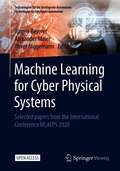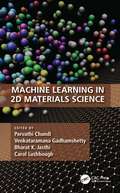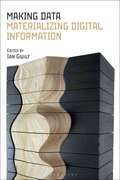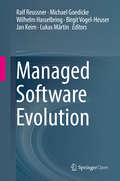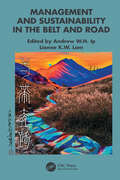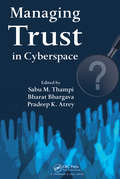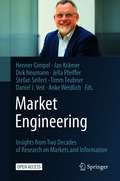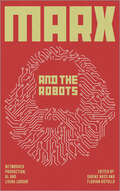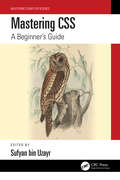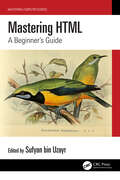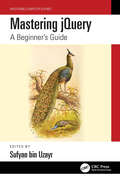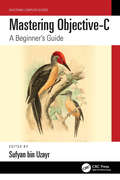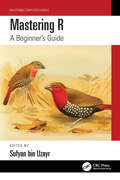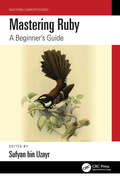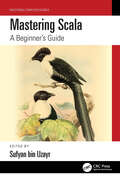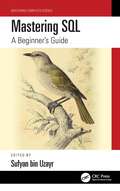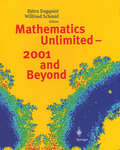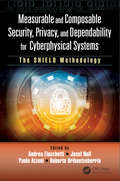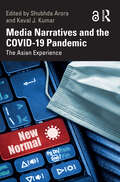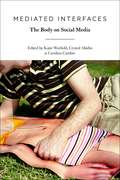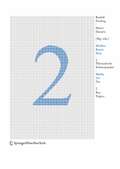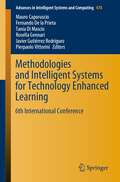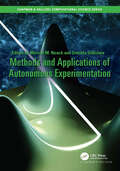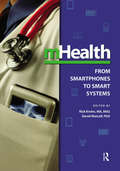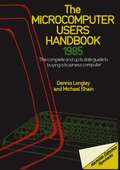- Table View
- List View
Machine Learning for Cyber Physical Systems: Selected papers from the International Conference ML4CPS 2020 (Technologien für die intelligente Automation #13)
This open access proceedings presents new approaches to Machine Learning for Cyber Physical Systems, experiences and visions. It contains selected papers from the fifth international Conference ML4CPS – Machine Learning for Cyber Physical Systems, which was held in Berlin, March 12-13, 2020. Cyber Physical Systems are characterized by their ability to adapt and to learn: They analyze their environment and, based on observations, they learn patterns, correlations and predictive models. Typical applications are condition monitoring, predictive maintenance, image processing and diagnosis. Machine Learning is the key technology for these developments.
Machine Learning in 2D Materials Science
Data science and machine learning (ML) methods are increasingly being used to transform the way research is being conducted in materials science to enable new discoveries and design new materials. For any materials science researcher or student, it may be daunting to figure out if ML techniques are useful for them or, if so, which ones are applicable in their individual contexts, and how to study the effectiveness of these methods systematically. KEY FEATURES • Provides broad coverage of data science and ML fundamentals to materials science researchers so that they can confidently leverage these techniques in their research projects. • Offers introductory material in topics such as ML, data integration, and 2D materials. • Provides in-depth coverage of current ML methods for validating 2D materials using both experimental and simulation data, researching and discovering new 2D materials, and enhancing ML methods with physical properties of materials. • Discusses customized ML methods for 2D materials data and applications and high-throughput data acquisition. • Describes several case studies illustrating how ML approaches are currently leading innovations in the discovery, development, manufacturing, and deployment of 2D materials needed for strengthening industrial products. • Gives future trends in ML for 2D materials, explainable AI, and dealing with extremely large and small, diverse datasets. Aimed at materials science researchers, this book allows readers to quickly, yet thoroughly, learn the ML and AI concepts needed to ascertain the applicability of ML methods in their research.
Making Data: Materializing Digital Information
For many outside of the scientific community, big data and the forms it takes, such as statistical lists, spreadsheets and graphs, often seem abstract and unintelligible. This book investigates how digital fabrication and traditional making approaches are being used to present data in newly engaging and interesting ways.The first part of the book introduces the basic premise of the data object and the concept of making digital data into a physical form. Contributors cover topics such as biometrics, new technology, the economics of data and open and community uses of data. The second part presents a selection of exemplar forms and contexts for the application of data-objects, such as smart surfaces, smart cities, augmented reality techniques and next generation technical interfaces that blend physical and digital elements.Making Data delivers the importance and likely future prevalence of physical representations of data. It explores the creative methods, processes, theories and cultural histories of making physical representations of information and proposes that the making of data into physical objects is the next important development in the data visualisation phenomenon.
Managed Software Evolution
This open access book presents the outcomes of the “Design for Future – Managed Software Evolution” priority program 1593, which was launched by the German Research Foundation (“Deutsche Forschungsgemeinschaft (DFG)”) to develop new approaches to software engineering with a specific focus on long-lived software systems. The different lifecycles of software and hardware platforms lead to interoperability problems in such systems. Instead of separating the development, adaptation and evolution of software and its platforms, as well as aspects like operation, monitoring and maintenance, they should all be integrated into one overarching process.Accordingly, the book is split into three major parts, the first of which includes an introduction to the nature of software evolution, followed by an overview of the specific challenges and a general introduction to the case studies used in the project. The second part of the book consists of the main chapters on knowledge carrying software, and cover tacit knowledge in software evolution, continuous design decision support, model-based round-trip engineering for software product lines, performance analysis strategies, maintaining security in software evolution, learning from evolution for evolution, and formal verification of evolutionary changes. In turn, the last part of the book presents key findings and spin-offs. The individual chapters there describe various case studies, along with their benefits, deliverables and the respective lessons learned. An overview of future research topics rounds out the coverage.The book was mainly written for scientific researchers and advanced professionals with an academic background. They will benefit from its comprehensive treatment of various topics related to problems that are now gaining in importance, given the higher costs for maintenance and evolution in comparison to the initial development, and the fact that today, most software is not developed from scratch, but as part of a continuum of former and future releases.
Management and Sustainability in the Belt and Road
China’s Belt and Road Initiatives (BRI) is an ambitious infrastructure project conceived in 2013 by President Xi Jinping with development and investment initiatives stretching from Asia and Europe that reflect the original Silk Road with business networks through countries such as Afghanistan, Kazakhstan, Kyrgyzstan, Tajikistan, Turkmenistan, and Uzbekistan, as well as India and Pakistan, spanning a route of more than 4,000 miles and history that can be dated back more than 2,200 years. Given the background of China’s unique approach in fighting COVID-19, and against the backdrop of sluggish economic growth, innovation, and management, sustainable development of BRI will be the key and the driving force for the post-pandemic economic recovery of many countries, especially as BRI countries now account for nearly 30% of China’s foreign trade and 15% of outward direct investment. The vision to create a vast network of railways, energy pipelines, highways, and streamlined border crossings to expand the international use of Chinese currency and improve connectivity to China is good foresight and proved fortuitous when the COVID-19 pandemic came to plague the world, and amid the conflicts between the United States and China as well as the war between Russia and Ukraine. Since the inception of BRI, many books have been written to cover topics ranging from globalization to detailing how China’s business and politics are a major motivation for China’s overseas economic activities with case studies and practices, yet few of these books provide a structured approach to the sustainable management of BRI projects. This book is about how to manage the innovation, sustainability, and business necessary to make BRI work and how to handle the issues, problems, and crises that may arise in the process. Participants of BRI projects can take on many different roles, but ultimately, it is team effort and leadership that creates successful projects. Here, readers will find guidelines and insights to survive and prosper in a myriad of BRI opportunities and risks. Most important of all, this book provides a glimpse of different approaches for success in BRI projects, including sustainability, environmental issues, social and political aspects, technology, choice of industry, project management, education and training, governance, and many more.
Managing Trust in Cyberspace
In distributed, open systems like cyberspace, where the behavior of autonomous agents is uncertain and can affect other agents' welfare, trust management is used to allow agents to determine what to expect about the behavior of other agents. The role of trust management is to maximize trust between the parties and thereby provide a basis for cooper
Market Engineering: Insights from Two Decades of Research on Markets and Information
This open access book provides a broad range of insights on market engineering and information management. It covers topics like auctions, stock markets, electricity markets, the sharing economy, information and emotions in markets, smart decision-making in cities and other systems, and methodological approaches to conceptual modeling and taxonomy development. Overall, this book is a source of inspiration for everybody working on the vision of advancing the science of engineering markets and managing information for contributing to a bright, sustainable, digital world. Markets are powerful and extremely efficient mechanisms for coordinating individuals’ and organizations’ behavior in a complex, networked economy. Thus, designing, monitoring, and regulating markets is an essential task of today’s society. This task does not only derive from a purely economic point of view. Leveraging market forces can also help to tackle pressing social and environmental challenges. Moreover,markets process, generate, and reveal information. This information is a production factor and a valuable economic asset. In an increasingly digital world, it is more essential than ever to understand the life cycle of information from its creation and distribution to its use. Both markets and the flow of information should not arbitrarily emerge and develop based on individual, profit-driven actors. Instead, they should be engineered to serve best the whole society’s goals. This motivation drives the research fields of market engineering and information management. With this book, the editors and authors honor Professor Dr. Christof Weinhardt for his enormous and ongoing contribution to market engineering and information management research and practice. It was presented to him on the occasion of his sixtieth birthday in April 2021. Thank you very much, Christof, for so many years of cooperation, support, inspiration, and friendship.
Marx and the Robots: Networked Production, AI and Human Labour
Marxist discourse around automation has recently become waylaid with breathless techno-pessimist dystopias and fanciful imaginations of automated luxury communism. This collection of essays by both established veterans of the field and new voices is a refreshingly sober materialist reflection on recent technological developments within capitalist production. It covers a broad range of digital aspects now proliferating across our work and lives, including chapters on the digitalisation of agriculture, robotics in the factory and the labour process on crowdworking platforms. It looks to how 20th century Marxist predictions of the ‘workerless factory’ are, or are not, coming true, and how ‘Platform Capitalism’ should be understood and critiqued. Through rich empirical, theoretical and historical material, this book is necessary reading for those wanting a clear overview of our digital world.
Mastering CSS: A Beginner's Guide (Mastering Computer Science)
Cascading Style Sheets (CSS) is an open-source programming language used in website building and HTML templates that integrates all relevant information related to web page displays. CSS is used to format the look and structure of a web page, as well as to set design features such as basic layout, colors, and fonts. CSS allows for continuity between different web pages on the website and makes webpage development easier and faster. This book has been created to help readers understand and learn the concepts of CSS. It discusses the fundamental concepts of CSS, including its properties and functions, and guides the reader through creating websites with it. Key Features: Examines the fundamentals of CSS, values, selectors, and queries Discusses its application in modern web development to help readers to quickly advance the necessary information Explores animations, grids, flexboxes, masking, filtering, and compositing using CSS Mastering CSS is a valuable resource for anyone who wants to create a website. After finishing this book, readers will quickly build their website with absolute ease, even if they were utterly oblivious to it before.
Mastering HTML: A Beginner's Guide (Mastering Computer Science)
An open-source, HyperText Markup Language, or HTML is a programming language used in website building and website templates. It is used to format the look and format of a web page, to set design features such as basic layout, colors, and fonts. CSS allows for continuity between different web pages on the site and makes webpage development easier and faster. CSS frameworks are used for developing responsive and mobile-friendly websites. Mastering HTML: A Beginner’s Guide examines the fundamental concepts of HTML, its history, all the different versions available, and its advantages and disadvantages. Written in a concise and easy-to-understand format, each chapter includes examples and details of correct code output and HTML. This book is a valuable resource for anyone who wants to create web page structures. After finishing this book, readers will be able to build their website quickly and with absolute ease. Key Features: Discusses basic concepts of HTML such as common HTML attributes, doctype declaration, Block level elements, inline elements, etc. Presents various elements, attributes and entities in HTML including a list of core attributes and entities used in HTML. Examines HTML Forms and other advanced topic such as Graphics, Canvas, SVG, etc. Introduces text formatting and links tags used in HTML such as blockquote, quotation, anchor and many more.
Mastering jQuery: A Beginner's Guide (Mastering Computer Science)
With a combination of flexibility and feature-rich design, jQuery has changed the way millions of people write JavaScript. It makes tasks such as HTML document conversion, animation, event management, and Asynchronous JavaScript and XML (AJAX) much easier with an easy-to-use API that works on a wide variety of browsers. This book is a detailed guide for beginners to understand jQuery and its programming techniques. It discusses the fundamental concepts of jQuery and provides a roadmap for creating websites using jQuery programming. Key Features: Follows a hands-on approach and offers practical lessons and tutorials related to jQuery Provides a special focus on animations and effects using jQuery programming Includes detailed tutorials meant for beginners to jQuery Mastering jQuery: A Beginner’s Guide is an exciting journey for anyone who wants to create an animated website. This is a valuable resource for developers already familiar with HTML and CSS and little understanding of JavaScript. After finishing this book, readers will be able to quickly build their website with absolute ease.
Mastering Objective-C: A Beginner's Guide (Mastering Computer Science)
Mastering Objective-C is a detailed guide for beginners that gives a modern programmer’s viewpoint on Objective-C. It introduces the principles of Objective-C and current Apple programming skills and libraries allowing the reader to make the best use of the tools available. Concise and easy to understand, this book covers many topics including, an introduction to key concepts of language and primary toolkits, as well as the Foundation and AppKit frameworks to help quickly advance with the necessary information. This book explains how to structure applications properly and organize code for optimum performance. The fundamental principles explained here are helpful to beginner and intermediate users interested in learning this highly technological and diverse language.
Mastering R: A Beginner's Guide (Mastering Computer Science)
R is a statistical computing and graphics programming language that you can use to clean, analyze, and graph data. It is widely used by researchers from various disciplines to estimate and display results and by teachers of statistics and research methods. This book is a detailed guide for beginners to understand R with an explanation of core statistical and research ideas. One of the powerful characteristics of R is that it is open-source, which means that anyone can access the underlying code used to run the program and add their own code for free. It will always be able to perform the latest statistical analyses as soon as anyone thinks of them. R corrects mistakes quickly and transparently and has put together a community of programming and statistical experts that you can turn to for help. Mastering R: A Beginner’s Guide not only explains how to program but also how to use R for visualization and modeling. The fundamental principles of R explained here are helpful to beginner and intermediate users interested in learning this highly technological and diverse language.
Mastering Ruby: A Beginner's Guide (Mastering Computer Science)
Ruby is a superb programming language used for a variety of activities such as developing desktop applications, static websites, computational services, and even automation systems. Mastering Ruby: A Beginner’s Guide is a detailed guide for beginners to understand Ruby. This book discusses how to structure applications properly and organize code for optimum performance. Concise and easy to understand, this book provides the fundamentals for web programming along with software development and simple app development. It covers a variety of topics, starting from syntax styles workflow for the Command line to creating websites that will quickly advance necessary information. The key principles about Ruby explained here are helpful to beginners and users interested in learning this highly technological and diverse language. Key Features: • Follows a hands-on approach and offers practical lessons and tutorials related to Ruby. • Provides an in-depth discussion of Ruby design and applications to help build robust knowledge. • Explains how to create individual websites using Ruby programming.
Mastering Scala: A Beginner's Guide (Mastering Computer Science)
Scala is a multi-paradigm, general-purpose scripting language. It is a completely object-oriented programming language that supports a functional programming technique. This book is a detailed guide for beginners to understand Scala. Concise and easy to understand, Mastering Scala: A Beginner’s Guide covers a comprehensive understanding of Scala and its components, libraries, and advance concepts to help readers quickly advance with the necessary information. This book provides functional approaches for solving queries using Scala. The fundamental principles of Scala explained here are helpful to beginner and intermediate users interested in learning this highly technical and diverse language. Key Features: Follows a hands-on approach and offers practical lessons and tutorials related to Scala Includes detailed tutorials meant for beginners to Scala Discusses Scala in-depth to help build robust knowledge
Mastering SQL: A Beginner's Guide (Mastering Computer Science)
Mastering SQL helps readers gain a firm understanding of the Structured Query Language. Structured Query Language, more often known as SQL, is the de facto standard language for working with databases. It is a specialized language for handling data-related tasks like creating a database, putting information into tables, modifying and extracting that information, and much more. MySQL, PostgreSQL, Oracle, SQL light, etc. are only a few examples of SQL implementations. SQL is a fast and efficient database system. SQL allows for the rapid and efficient retrieval of huge numbers of data entries from a database. It’s a relational database. Thus, data is described in a more orderly fashion than in an unstructured database like MongoDB. Insertions, deletions, inquiries, manipulations, and computations of data through analytical queries in a relational database may all be performed in a matter of seconds. With Mastering SQL, learning SQL becomes straightforward; using this book and resource will undoubtedly help readers advance their careers. The Mastering Computer Science series is edited by Sufyan bin Uzayr, a writer and educator with over a decade of experience in the computing field.
Mathematics Unlimited - 2001 and Beyond
This is a book guaranteed to delight the reader. It not only depicts the state of mathematics at the end of the century, but is also full of remarkable insights into its future de- velopment as we enter a new millennium. True to its title, the book extends beyond the spectrum of mathematics to in- clude contributions from other related sciences. You will enjoy reading the many stimulating contributions and gain insights into the astounding progress of mathematics and the perspectives for its future. One of the editors, Björn Eng- quist, is a world-renowned researcher in computational sci- ence and engineering. The second editor, Wilfried Schmid, is a distinguished mathematician at Harvard University. Likewi- se the authors are all foremost mathematicians and scien- tists, and their biographies and photographs appear at the end of the book. Unique in both form and content, this is a "must-read" for every mathematician and scientist and, in particular, for graduates still choosing their specialty. Limited collector's edition - an exclusive and timeless work. This special, numbered edition will be available until June 1, 2000. Firm orders only.
Measurable and Composable Security, Privacy, and Dependability for Cyberphysical Systems: The SHIELD Methodology
With a business baseline focused on the impact of embedded systems in the years ahead, the book investigates the Security, Privacy and Dependability (SPD) requirements raised from existing and future IoT, Cyber-Physical and M2M systems. It proposes a new approach to embedded systems SPD, the SHIELD philosophy, that relies on an overlay approach to SPD, on a methodology for composable SPD, on the use of semantics, and on the design of embedded systems with built-in SPD. The book explores new ground and illustrates the development of approximately forty prototypes capable of managing and enhancing SPD, including secure boot, trusted execution environments, adaptable radio interfaces, and different implementations of the middleware for measuring and composing SPD.
Media Narratives and the COVID-19 Pandemic: The Asian Experience
This volume investigates mediated lives and media narratives during the Covid-19 pandemic, with Asia as a focus point. It shows how the pandemic has created an unprecedented situation in this globalized world marked by many disruptions in the social, economic, political, and cultural lives of individuals and communities— creating a ‘new normal’. It explores the different media vocabularies of fear, panic, social distancing, and contagion from across Asian nations. It focuses on the role media played as most nations faced lockdowns and unique challenges during the crisis. From healthcare workers to sex workers, from racism to nationalism, from the plight of migrant workers in news reporting to state propaganda, this book brings critical questions confronting media professionals into focus.The volume is of critical interest to scholars and researchers of media and communication studies, politics, especially political communication, social and public policy, and Asian studies.
Mediated Interfaces: The Body on Social Media
Images of faces, bodies, selves and digital subjectivities abound on new media platforms like Snapchat, Instagram, YouTube, and others-these images represent our new way of being online and of becoming socially mediated. Although researchers are examining digital embodiment, digital representations, and visual vernaculars as a mode of identity performance and management online, there exists no cohesive collection that compiles all these contemporary philosophies into one reader for use in graduate level classrooms or for scholars studying the field. The rationale for this book is to produce a scholarly fulcrum that pulls together scholars from disparate fields of inquiry in the humanities doing work on the common theme of the socially mediated body. The chapters in Mediated Interfaces: The Body on Social Media represent a diverse list of contributors in terms of author representation, inclusivity of theoretical frameworks of analysis, and geographic reach of empirical work. Divided into three sections representing three dominant paradigms on the socially mediated body: representation, presentation, and embodiment, the book provides classic, creative, and contemporary reworkings of these paradigms.
Medien Kunst Netz 2 / Media Art Net 2: Thematische Schwerpunkte / Key Topics
Das Werk bietet aktuelle Diskurse der Medienkunst im internationalen Kontext und ist gleichzeitig das Buch zur Onlineplattform www.medienkunstnetz.de. Thematische Schwerpunkte lokalisieren die Schnittstellen zwischen den Medien und Künsten. Essays und Texte von Inke Arns, Dieter Daniels, Steve Dietz, Rudolf Frieling, Susanne Holschbach, Verena Kuni, Gregor Stemmrich und Yvonne Volkart als vertiefende Ergänzung zu Band 1: Medienkunst im Überblick. Beide Bände werden online durch multimediale und audiovisuelle Werkdarstellungen ergänzt. Themenschwerpunkte u. a.: Essays zu Bild-Ton-Relationen, Cyborg Bodies, Foto/Byte, Generative Tools, Mapping und Text, Public Sphere_s.
Methodologies and Intelligent Systems for Technology Enhanced Learning: 6th International Conference (Advances in Intelligent Systems and Computing #478)
The 6th International Conference in Methodologies and intelligent Systems for Technology Enhanced Learning held in Seville (Spain) is host by the University of Seville from 1st to 3rd June, 2016. The 6th edition of this conference expands the topics of the evidence-based TEL workshops series in order to provide an open forum for discussing intelligent systems for TEL, their roots in novel learning theories, empirical methodologies for their design or evaluation, stand-alone solutions or web-based ones. It intends to bring together researchers and developers from industry, the education field and the academic world to report on the latest scientific research, technical advances and methodologies.
Methods and Applications of Autonomous Experimentation (Chapman & Hall/CRC Computational Science)
Autonomous Experimentation is poised to revolutionize scientific experiments at advanced experimental facilities. Whereas previously, human experimenters were burdened with the laborious task of overseeing each measurement, recent advances in mathematics, machine learning and algorithms have alleviated this burden by enabling automated and intelligent decision-making, minimizing the need for human interference. Illustrating theoretical foundations and incorporating practitioners’ first-hand experiences, this book is a practical guide to successful Autonomous Experimentation. Despite the field’s growing potential, there exists numerous myths and misconceptions surrounding Autonomous Experimentation. Combining insights from theorists, machine-learning engineers and applied scientists, this book aims to lay the foundation for future research and widespread adoption within the scientific community. This book is particularly useful for members of the scientific community looking to improve their research methods but also contains additional insights for students and industry professionals interested in the future of the field.
mHealth: From Smartphones to Smart Systems (HIMSS Book Series)
mHealth: From Smartphone to Smart Systems provides a high level and comprehensive survey of the emergence of mobile technology healthcare. This book looks beyond the already-popular devices and apps associated with mHealth, exploring the major role this technology could play as healthcare steers inexorably toward an architecture
